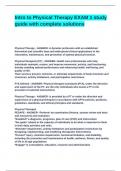Intro to Physical Therapy EXAM 1 study
guide with complete solutions
Physical Therapy - ANSWER- A dynamic profession with an established
theoretical and scientific base and widespread clinical applications in the
restoration, maintenance, and promotion of optimal physical function.
Physical therapists (PT) - ANSWER- Health care professionals who help
individuals maintain, restore, and improve movement, activity, and functioning,
thereby enabling optimal performance and enhancing health, well-being, and
quality of life.
Their services prevent, minimize, or eliminate impairments of body functions and
structures, activity limitations, and participation restrictions.
PTA Defined - ANSWER- Physical therapist assistants (PTA), under the direction
and supervision of the PT, are the only individuals who assist a PT in the
provision of selected interventions
Physical Therapy - ANSWER- is provided by a PT or under the direction and
supervision of a physical therapist in accordance with APTA policies, positions,
guidelines, standards, and ethical principles and standards.
Physical Therapist
PESAPE - ANSWER- *Perform* an examination (history, system review and tests
and measures) and evaluation
*Establish* a diagnosis, prognosis, plan of care (POC) and intervention
*Set goals* related to the capacity of individuals to do what is important to them
in their daily activities and roles
*Alleviate* impairments, activity limitations and participation restrictions by
designing, implementing, and modifying therapeutic interventions
*Prevent* injury, minimize impairments, functional limitation, and disability,
including the promotion and maintenance of health, wellness, fitness, and quality
of life in all age populations
*Engage* in consultation, education, research and administration
, POC - ANSWER- is based on clinical judgment, best available evidence, and an
individual's situation and goals
Medical Diagnosis - ANSWER- - is determined by a physician
(Medical doctor - MD, Doctor of Osteopathy - DO) who identifies an illness or
disorder through an interview, physical examination, medical tests, lab tests,
imaging, & other procedures.
-recognizes a disease & attempts to determine the underlying causes / pathology
-Physicians use labels to identify disease, disorder, condition at level of cell,
organ, tissue, or system
PT Diagnosis - ANSWER- - is determined by the PT as the end result of evaluating
information obtained from the exam.
-The PT will then organize into defined clusters, syndromes, or categories to help
determine the most appropriate intervention strategies. (APTA Guide to PT)
-PTs use labels that identify the impact of a condition on function at the system
level (especially the movement system & at the level of the whole body.
-Impairments, Functional Limitations, Disability
Intervention - ANSWER- performed by PT or PTA
*Purposeful interactions between PT/PTA and patient, using various physical
therapy procedures and techniques to reach established goal
Reexamination - ANSWER- *Performing selected tests and measures after initial
examination to modify or redirect intervention.
*Indications for reexamination include new clinical findings and failure to respond
to intervention
Outcomes - ANSWER- As termination of physical therapy services is reached,
outcomes are measured to assess the impact of physical therapy interventions
on pathology, impairments, activity limitations, participation restrictions, risk
reduction/prevention, wellness, and patient satisfaction
Mary McMillan, 1921, AWTA - ANSWER- American Women's Physical Therapeutic
Association
AWTA
reconstruction aides - ANSWER- beginning of PT




